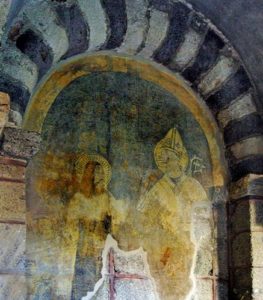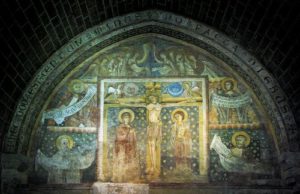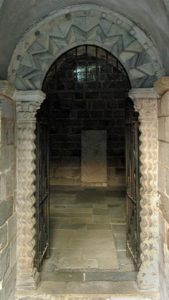The Cloisters are on the outside of the north wall of the cathedral (see separate review).
We visited on one of the journees-du-patrimoine, so entry to the cloisters was free although the Treasury was shut. The arcades have striped arches made of alternating black and white stones. The upper walls have a mosaic pattern of black, red and white geometric shapes. Running along the top of the entire cloister is a carved frieze with battling animals, mythical beasts, monsters and a few humans. The four Evangelists are in the corners.
There are rows of pillars on either side of the cloisters which support the vaulted ceiling. All have carved capitals. Most are carved with a foliage designs. They are worth close examination as there are some delightful capitals with doves drinking from a chalice, an angel snatching a soul from two devils, a battle between a monk and an abbess over a crozier, symbol of authority, with devils laughing at them and a male centaur pursuing a female and catching her by the tail.
There is a 12th-century Romanesque metal gate with beautiful Moorish-style ironwork across the west gallery.
The Chapter House (Salle capitulaire ) is on the east gallery and reached through a doorway with pillars carved into a wave pattern with a zigzag round arch above. This was the burial place for canons until the Revolution and there are old tombstones displayed along the walls. The end wall is covered with a fresco from around 1200 depicting the Crucifixion. The Virgin, St. John, sun and moon are flanked by the prophets Isaiah, Jeremiah, Hosea and Philo Judaeus ( Philo of Alexandria who died in 50 AD). Each prophet holds a scroll with the text of their prophecy about Christ. An inscription above the fresco proclaims that it was executed in "a hundred days minus one."
Above the cloisters was the Clergeons house which provided high standard living accommodation for young clerymen or choirboys from the Cathedral school. . Above the west gallery is the library building.
Exit is by a small bookstall which has model of cathedral and cloisters.
The cloisters are well worth visiting. We were disappointed we were unable to get into the Treasury, which is in the Chapelle des Reliques which was the winter Chapel with a beautiful gold altar piece. It has a large number of works of art including an 11thC silk cope, 13thC engraved enamel reliquary, polychrome 15thC nursing Virgin and a 16thC embroidered cloak for the Black Virgin.










